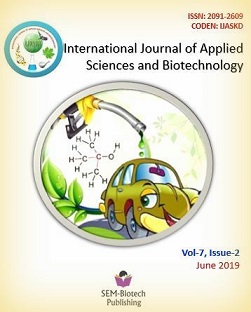Variability Study of Biofortified Bread Wheat Genotypes for Grain Zinc and Iron Concentration, Yield and Yield Associated Traits at Khumaltar, Lalitpur, Nepal
DOI:
https://doi.org/10.3126/ijasbt.v7i2.23433Keywords:
Biofortified wheat, Grain Zinc, Triticum aestivumAbstract
Bread wheat ( Triticum aestivum L.) is third major cereal crop of Nepal where cereal based foods represent the largest proportion of the daily diet. Lack of diverse food habit in the country is resulting micronutrient deficiency. This could be addressed by introducing biofortified bread wheat genotypes. This field research was conducted at Agriculture Botany Division, Khumaltar, Lalitpur to study the variability of biofortified bread wheat genotypes for grain zinc, iron, yield, yield attributes and identify high yielding genotypes with high grain zinc and iron concentration. 50 wheat genotypes (47 biofortified, 3 checks) were tested in alpha lattice design with two replications. Data on grain zinc, iron, yield and yield attributes were recorded and analyzed (α=5%). Genotypes differed significantly for the studied traits which provide an opportunity to improve the existing germplasms for targeted traits and environment. Grain yield was correlated positively with effective tiller, plant height, days to maturity, grains per spike and negatively with thousand grain weight. Grain zinc and iron concentration were significantly positively correlated but had positive non-significant relation with grain yield suggesting simultaneous improvement of both micronutrients without compromising grain yield is possible. Effective tiller and peduncle length can be used as selection criteria for high grain yield and micronutrient concentration respectively. Superior genotypes containing higher grain iron, zinc and yield can be used as parent in breeding for developing zinc and iron enriched varieties.




